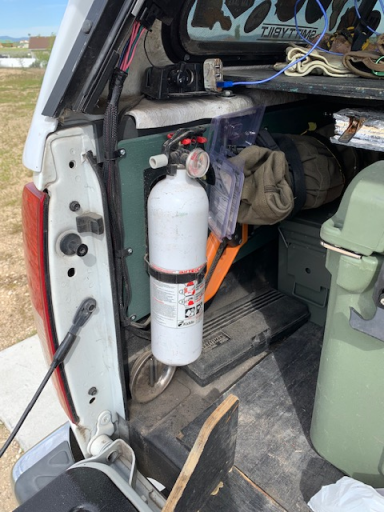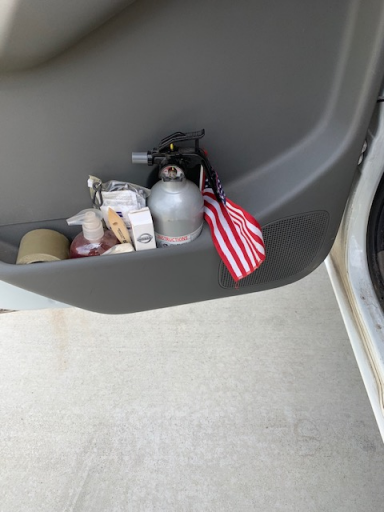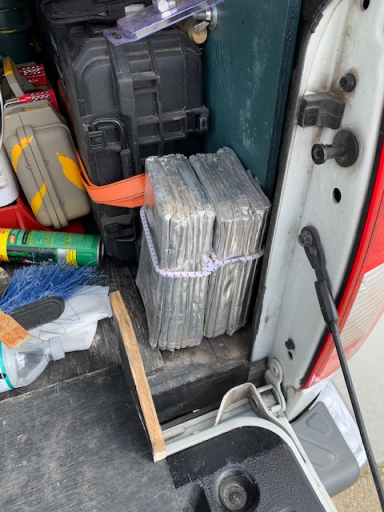This is so helpful! Thank youThe next piece of your safety kit should be a quality fire extinguisher. No matter the age of your vehicle, this should be a standard piece of equipment in every overland rig.
I'm going to keep this article short and to the point so let's get started...
Selection
Select a fire extinguisher based on your anticipated needs. A unit that is rated for B & C fires should be a minimum criteria for a vehicle unit. However, if you live in a forest fire potential area you might consider a A-B-C unit since the B & C only units aren't as effective on brush fires. (Note: Stopping or parking in tall grass can start a fire due to the intense heat in your catalytic converter.)
Here are is a list of the different classes and what they're used for:
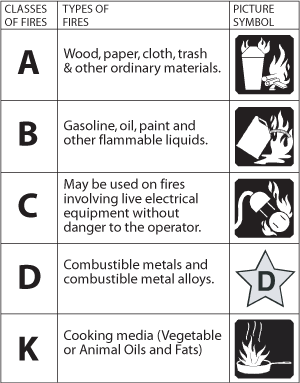
Composition
- Class A extinguishers are for ordinary combustible materials such as paper, wood, cardboard, and most plastics. The numerical rating on these types of extinguishers indicates the amount of water it holds and the amount of fire it can extinguish. Geometric symbol (green triangle)
- Class B fires involve flammable or combustible liquids such as gasoline, kerosene, grease and oil. The numerical rating for class B extinguishers indicates the approximate number of square feet of fire it can extinguish. Geometric symbol (red square)
- Class C fires involve electrical equipment, such as appliances, wiring, circuit breakers and outlets. Never use water to extinguish class C fires - the risk of electrical shock is far too great! Class C extinguishers do not have a numerical rating. The C classification means the extinguishing agent is non-conductive. Geometric symbol (blue circle)
- Class D fire extinguishers are commonly found in a chemical laboratory. They are for fires that involve combustible metals, such as magnesium, titanium, potassium and sodium. These types of extinguishers also have no numerical rating, nor are they given a multi-purpose rating - they are designed for class D fires only. Geometric symbol (Yellow Decagon)
- Class K fire extinguishers are for fires that involve cooking oils, trans-fats, or fats in cooking appliances and are typically found in restaurant and cafeteria kitchens. Geometric symbol (black hexagon)
The type of agent within the unit may be something to consider if you want to minimize clean-up and potential damage to other components.
Excerpt from: Fire Extinguisher: 101
"Water extinguishers or APW extinguishers (air-pressurized water) are suitable for class A fires only. Never use a water extinguisher on grease fires, electrical fires or class D fires - the flames will spread and make the fire bigger! Water extinguishers are filled with water and are typically pressurized with air. Again - water extinguishers can be very dangerous in the wrong type of situation. Only fight the fire if you're certain it contains ordinary combustible materials only.
Dry chemical extinguishers come in a variety of types and are suitable for a combination of class A, B and C fires. These are filled with foam or powder and pressurized with nitrogen.BC - This is the regular type of dry chemical extinguisher. It is filled with sodium bicarbonate or potassium bicarbonate. The BC variety leaves a mildly corrosive residue which must be cleaned immediately to prevent any damage to materials.
ABC - This is the multipurpose dry chemical extinguisher. The ABC type is filled with monoammonium phosphate, a yellow powder that leaves a sticky residue that may be damaging to electrical appliances such as a computer."
Mounting
A 2.5 pound metal cylinder running free in your luggage compartment or back seat is recipe for potential vehicle damage or personal injury in the event of a collision or rollover. Strap that puppy down. This will not only keep you safe, but ensure you know where it is when you need it most.
Also, ensure you mount it in an accessible location that won't be covered up when your rig is loaded up like the Beverly Hillbillies.
Extinguishing a Car Fire
1) Stop the vehicle and PUT IT IN PARK. It's easy to forget this step in an emergency. The last thing you need is a fireball rolling away from you while you're trying to dig out your extinguisher.
2) Get the passengers out of the vehicle, especially if they're kids. A few seconds hesitation trying to fight the fire before this step, could be a step in the wrong direction with tragic results. I know this goes against instinct but priorities are people, not vehicles. Call 911 at this point if possible.
3) Pull the pin on the extinguisher. Sounds silly, right? You would be surprised what you will forget in a rush. Best to have it in your mind now to help prepare yourself mentally.
4) If the fire is under the hood, pop the latch, but do not open it. Spray the extinguisher through the crack below the hood before attempting to open it all the way. A concealed fire in the engine compartment may be having trouble breathing if there is a lot of smoke. Opening the hood first could cause it to flare.
5) Always aim the extinguisher at the base of the fire. This might be difficult to locate in a tangle of components.
First, how NOT to extinguish a car fire:
Good discussion on car fire extinguishers:
Suggestions
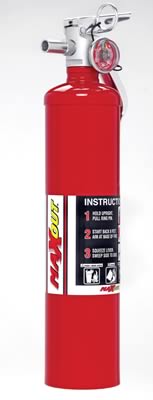
2.5 lb ABC Dry Agent Unit $60 (I own this one)
H3R Performance MaxOut Fire Extinguishers MX250R
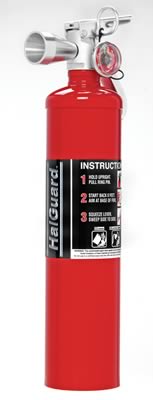
2.5 lb B & C Halotron Unit $135
H3R Performance HalGuard Fire Extinguishers HG250R
As always, I'm open to questions or comments on this topic.
OB Approved Overland Safety: Fire Extinguishers
- Thread starter Lifestyle Overland
- Start date
I opted for CO2 10lb.
Exactly what I need in terms of reaction to an emergency and care of my team.
Exactly what I need in terms of reaction to an emergency and care of my team.

Member III
- 2,771
- First Name
- Rolando
- Last Name
- Nispiros
- Member #
-
17011
- Ham/GMRS Callsign
- KN6JJS
Happy to have gotten mine installed today in the back of my truck. I previously had it in its box inside of a bin. No use in there. [emoji20]

Enthusiast III
There may be a storage instructions on the box of your fire extinguishers, if not on a warning label on the extinguisher itself regarding temperatures. Also a fire blanket may be useless in the case of an engine fire because air will come up from underneath but a fire blanket would be useful in a camp site. I carry two fire shelters in my truck the may be used the same way if necessary.Long story short ...
Long time ago I left a so-called "reputable" dealership garage after a simple oil change. Before driving a couple of miles I noticed smoke rising from my engine compartment. Pulling off to the shoulder, I removed my child from the vehicle and within seconds the car was in flames. The fire department said it looked like a rag was sitting on the manifold and it had ignited. I had no experience, and there were no cell phones then. I couldn't prove who destroyed my car (no doubt a shop mechanic left the rag), so with only minimum insurance I lost everything that day.
I wished I'd had an extinguisher to have prevented a total loss. Needless to say, I raise the hood every time before pulling out of any service bay or garage parking lot.
Back to the subject ...
I have two questions.
First, in my reading all the info here, does anyone know if there are temperature limitations on these fire extinguishers? Not the water tank kind, but the chemical/powder kind you are discussing? As related to storing one in a vehicle, what's the highest and lowest outdoor temps the extinguisher can withstand while in a vehicle before damage would occur?
Second question, sort of related ... Does anyone keep a welder's blanket or fire blanket of some kind for fire emergencies with their extinguisher as a backup? Something to cover a fire to help suffocate flames or sparks?
I would appreciate feedback as I can't see investing all kinds of money into my vehicle and not be adequately prepared for such emergencies.
Thanks ahead.
Attachments
-
570.4 KB Views: 124
-
349.3 KB Views: 125
-
571.2 KB Views: 118

Influencer I
Really good to hear that so many are interested in Extinguishers. It should be the first part of any Off Road Kit. Please keep it coming, the ideas on the mounting and other ideas are invaluable..

Enthusiast III
my response team has started to leverage this site: Responder Safety, Training, Learning Network .
This course is targeting vehicle fires: Special Circumstances: Safe Operations for Vehicle Fires .
interesting and useful data.
This course is targeting vehicle fires: Special Circumstances: Safe Operations for Vehicle Fires .
interesting and useful data.
I would not worry about normal temps too much. It would require an extreame spike in temp to have an extinguisher fail and leak. The ones i use at work are halon and will safely discharge if they get too hot thus over pressurize.Long story short ...
Long time ago I left a so-called "reputable" dealership garage after a simple oil change. Before driving a couple of miles I noticed smoke rising from my engine compartment. Pulling off to the shoulder, I removed my child from the vehicle and within seconds the car was in flames. The fire department said it looked like a rag was sitting on the manifold and it had ignited. I had no experience, and there were no cell phones then. I couldn't prove who destroyed my car (no doubt a shop mechanic left the rag), so with only minimum insurance I lost everything that day.
I wished I'd had an extinguisher to have prevented a total loss. Needless to say, I raise the hood every time before pulling out of any service bay or garage parking lot.
Back to the subject ...
I have two questions.
First, in my reading all the info here, does anyone know if there are temperature limitations on these fire extinguishers? Not the water tank kind, but the chemical/powder kind you are discussing? As related to storing one in a vehicle, what's the highest and lowest outdoor temps the extinguisher can withstand while in a vehicle before damage would occur?
Second question, sort of related ... Does anyone keep a welder's blanket or fire blanket of some kind for fire emergencies with their extinguisher as a backup? Something to cover a fire to help suffocate flames or sparks?
I would appreciate feedback as I can't see investing all kinds of money into my vehicle and not be adequately prepared for such emergencies.
Thanks ahead.
What a great original post, thread, and follow up. Two questions:I'd like to make some recommendations. My background is in aviation life support and part of my job is the maintenance of the fire suppression systems that are used on board. Currently most aircraft use a Halon 1211 & 1301 based agent which works great against types A,B,C fires. It leaves little to no residue and is safe around sensitive equipment (like aircraft engines and electronics). The downside is its not manufactured anymore because it contains ozone depleting chemicals and is being phased out so it will be hard to recharge. However you can still find them on the market with recycled halon for the next couple of years until their no longer sold. Halon is being replaced by HFC-125 (also known as FE-25). Its a clean agent (no residue) and is good against A,B,C type fires. It also doesn't contain ozone depleting chemicals. Its dispersed as a gas, and works best in contained areas (like engine bays). It will not damage electronics or sensitive equipment and also helps to cool the fire down rapidly. HFC-125's down side is its not widely available outside of the aviation market and is usually used as a centralized flooding agent in a system, not as a hand held extinguisher. Which brings us to Halotron (HCFC-123 based) units. Halotron (also known as halotron1) is a quick evaporating liquid that turns into a gas state during dispersal, its rated for B,C type fires, is safe for use around occupied areas, and does not damage electronics or other sensitive equipment. While its not specifically rated for class A fires (wood, paper, cloth, rubber, plastics) when used in smaller quantities (less than 9 lbs) it will still have an effect on these types of fires by rapidly cooling and interfering with the chemical reaction of a fire. Lastly, CO2 extinguishers are common and widely available, disperse as a gas, are effective against class B,C type fires and rapidly cool the combusting items. It's not rated to class A because it can blow embers and combustible material around while being dispersed. Also CO2 can cause suffocation and frostbite in an enclosed area (like the interior of a car). I would only recommend the dry chemical and powder agents as backup or secondary for a number of reasons; 1) Their messy. 2) They cant put out what the agent doesn't touch (nooks and corners of an engine bay). 3) You need a larger amount to fight the same size fire compared to the other agents. 4) It's a lot heavier. 5) Not always effective against flare-ups or recurring fire due to a fires heat. There are also dispersal systems that activate directly into the engine bay either automatically or manually, but you should make sure you use it with the correct fire suppression agent that its rated for. I would also recommend a 5lb or greater bottle with a directional horn to guide the agent and bracket with a quick spring release that wraps around the bottle when stowed. That way it wont move around in the vehicle and be a danger during an accident and is easily accessed.
1. @bshagopian based on what you've said above, can you provide links to any specific fire extinguishers OB members might consider that fit the bill?
Everyone else, to summarize the advice that I'm taking away from this thread based on the input of many posters, it sounds like the consensus is metal, not plastic extinguishers in 2.5 lb. or bigger, directional cone or hose if possible, at least B and C (possibly purple K) -- though I would encourage anyone new to the thread to read all the details and advice provided in this thread. Which leads me to my second question directed at everyone.
2. What have others found in terms of balancing budget and quality for extinguishers and mounts? Please post links for others to follow.
Again, great thread on an important topic.
Last edited:

Influencer I
I did not see where @bshagopian talked about Purple-K but I would seriously read up on the properties of Purple-K before buying, using, or recommending it. Like I stated before in this thread, it is highly corrosive to aluminum. We took down all 12 of our Purple-K extinguishers in our hangars where we house helicopters so putting out a small fire on the aircraft would not cause more damage than the fire itself. I am no expert nor do I work in the fire suppression industry like @bshagopian, I just know what I know from experience. Please do your own homework and listen to professionals with training like @bshagopian who does have the training, ask a ton of questions, fire is no joking matter and lives could be at risk. Stay safe everyone.....What a great original post, thread, and follow up. Two questions:
1. @bshagopian based on what you've said above, can you provide links to any specific fire extinguishers OB members might consider that fit the bill?
Everyone else, to summarize the advice, it sounds like the consensus is metal, not plastic extinguishers in 2.5 lb. or bigger, directional cone or hose if possible, at least B and C (possibly purple K) -- though I would encourage anyone new to the thread to read all the details and advice provided in this thread. Which leads me to my second question directed at everyone.
2. What have others found in terms of balancing budget and quality for extinguishers and mounts? Please post links for others to follow.
Again, great thread on an important topic.

Pathfinder I
Purple K(siliconized potassium bicarbonate)is NOT nearly as corrosive to aluminum as the typical sodium bicarbonate based ABC extinguishers that are so cheap and readily available. Purple K is used on ramps, fuel carts, and in hangers around the entire country AS dictated by fire code. It is there because it excels specifically in extinguishing liquid fueled fires in open or nearly open spaces, where halon, and CO2 have problems extinguishing. In a confined space like a closed engine bay or a cockpit halon or other gas based agents excel though they are less than amazing for the occupants if the cockpit can’t be vented or exited rapidly.I did not see where @bshagopian talked about Purple-K but I would seriously read up on the properties of Purple-K before buying, using, or recommending it. Like I stated before in this thread, it is highly corrosive to aluminum. We took down all 12 of our Purple-K extinguishers in our hangars where we house helicopters so putting out a small fire on the aircraft would not cause more damage than the fire itself. I am no expert nor do I work in the fire suppression industry like @bshagopian, I just know what I know from experience. Please do your own homework and listen to professionals with training like @bshagopian who does have the training, ask a ton of questions, fire is no joking matter and lives could be at risk. Stay safe everyone.....
https://www.amerex-fire.com/upl/downloads/tech-tips/use-of-abc-dry-chemical-in-the-vicinity-of- aircraft-0141461c.pdf
The reason I carry a purple K extinguisher in the truck is I’ve seen fuel tanks opened like tin cans on obstacles releasing gallons of fuel onto the ground under the vehicle. I’ve also seen a tip tank touch the tarmac on touch down and pull into the FBO dripping. Should either ignite that 5 lbs gives me the best chance at getting the few extra seconds to get the occupants out if it ignites.
I have huge CO2 in my garage, and smaller one over my CNC, and smaller halon in the plane, big ABC under the kitchen sink. The extinguisher should best fit the potential fire risk that’s why there are all the different types.
A few years back I had a neighbor flip a riding mower trying to mow a hillside and end up with 2nd and 3rd degree burns covering 80% of his body. I’ve done lots of research since and purchased several dozen different extinguishers for home, work, and our different vehicles.
@HeliSniper, he didn't and I wasn't suggesting that he said that -- although I can see how it could be read that way. Anyway, I was just summarizing my takeaways from reading all the posts, including a recommendation for Purple K and I encouraged others to read the entire thread so they can see your disagreement on Purple K. Bottom line, though, I'm hoping @bshagopian and others can chime in with more sound advice and recommendations/links.I did not see where @bshagopian talked about Purple-K but I would seriously read up on the properties of Purple-K before buying, using, or recommending it. Like I stated before in this thread . . . .

Pathfinder I
madcratebuilder
Rank V

Pathfinder I
I saw one person post about the Element E50, these are space age tech. I keep 3 old school extinguishers in the cab of the truck. My main concern is a vehicle fire and I keep a E50 in the front seat back pouch. These give you a minute of suppression and do no damage. I may pick up a second one if they have a black Friday sale this year.
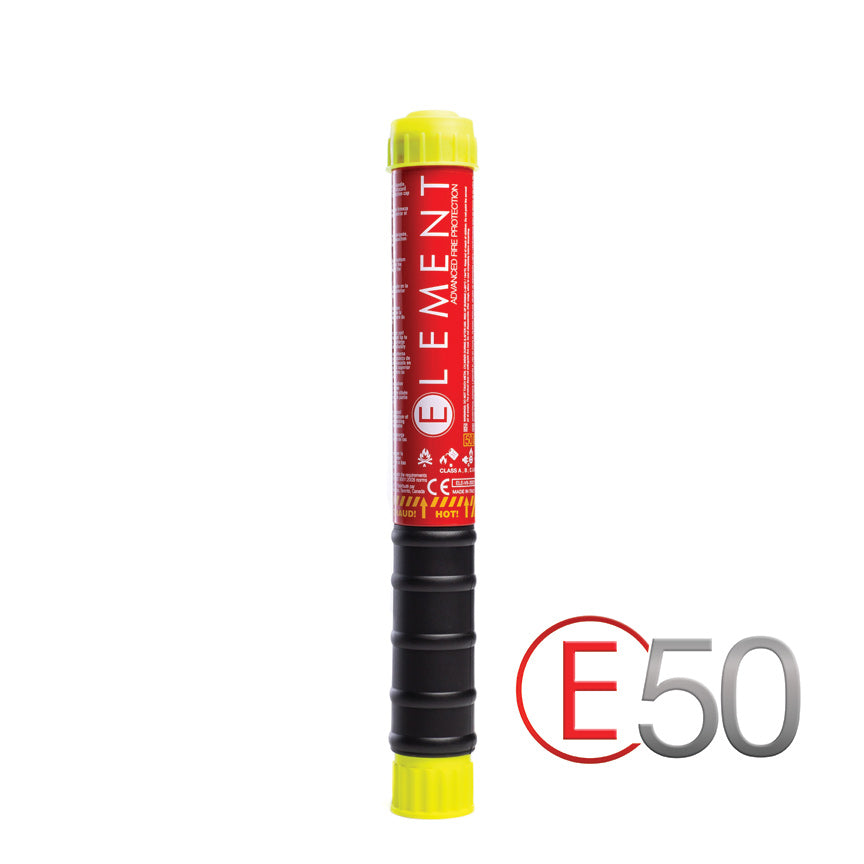
 elementfire.com
elementfire.com

Element | E50
Our most popular model. Offering 50 seconds of fire fighting protection, E50 is recommended for professional use (automotive, power sports, garage, marine, etc). E50's extremely small and lightweight construction allow for storage almost anywhere. Internationally tested and certified. FEATURES...

Expedition Master III
---------------------------------------------------------------------------------------------------------------------------------------------------------------------------------------------------------------------------------------I saw one person post about the Element E50, these are space age tech. I keep 3 old school extinguishers in the cab of the truck. My main concern is a vehicle fire and I keep a E50 in the front seat back pouch. These give you a minute of suppression and do no damage. I may pick up a second one if they have a black Friday sale this year.

Element | E50
Our most popular model. Offering 50 seconds of fire fighting protection, E50 is recommended for professional use (automotive, power sports, garage, marine, etc). E50's extremely small and lightweight construction allow for storage almost anywhere. Internationally tested and certified. FEATURES...elementfire.com
Seems reasonable in price, when compared to a quality regular 2.5 lb. ABC unit, and very comparable to the price of a 5 lb. bottle. I can not remember what a 5 lb. ABC will last for, when using from start to finish, but the 50 seconds of the E50 has to at least match it or exceed a standard unit.
I will have to put this on my watch list also, as the holidays are coming, and this compact unit is very intriguing. The NO RESIDUE feature is great, as it seems to be all thumbs up vs a thumbs down after being used
ELEMENT 60400
$158.42
EDIT: which site was this on?.. The Manufacturers?,...............Amazon only offers the this model of it, and as you can see, it is much more pricey.
--------------------------------------------------------------------------------------------------------------------------------------------------------------------------------------------------------------------------------------------
This is what I was originally thinking.....
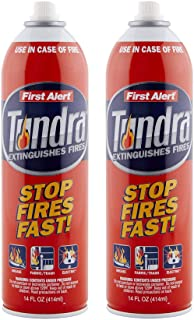 This one of those 2 is 1, and one is none items. If you have ever watched COYOTE WORKS on You-Tube, you know he lost his jeep to a fire out in the middle of nowhere (BFE) with no help around. He went thru his extinguisher and had it almost knocked down when he ran out of....juice! Filmed the whole thing...very sad at the time.
This one of those 2 is 1, and one is none items. If you have ever watched COYOTE WORKS on You-Tube, you know he lost his jeep to a fire out in the middle of nowhere (BFE) with no help around. He went thru his extinguisher and had it almost knocked down when he ran out of....juice! Filmed the whole thing...very sad at the time.
Last edited:

Member III
- 2,827
- First Name
- Joshua
- Last Name
- Downs
- Member #
-
20468
- Ham/GMRS Callsign
- KK6RBI / WQYH678
- Service Branch
- USMC 03-16, FIRE/EMS
I do love me some CO2 extinguishers but fires have a tendency to reignite when using them especially class A or C fires. When the CO2 dissipates and O2 comes back in they light back off. They made us extinguish Class A fires with CO2 extinguishers in the FIre Academy. Took a while 
I carry a basic dry chem in the cargo area and one of the Tundras in the center console. There's really no good spot to mount any other kind of extinguisher up front so I figure the Tundra type can can give me time to vacate if needed and get to the larger one in the cargo area.
I can't afford a HALON extinguisher., a Purple K would be great. It's true what was stated earlier in the thread. Dry Chem will eat up your engine compartment.
Another good addition that I need to install on my Jeep is a battery quick disconnect. If you have an electrical fire going on in your vehicle the only way to get it out for good is to get the battery unhooked. Digging for tools to do so in an emergency could be bad so it pays to have one of these low cost devices as a safety.
I carry a basic dry chem in the cargo area and one of the Tundras in the center console. There's really no good spot to mount any other kind of extinguisher up front so I figure the Tundra type can can give me time to vacate if needed and get to the larger one in the cargo area.
I can't afford a HALON extinguisher., a Purple K would be great. It's true what was stated earlier in the thread. Dry Chem will eat up your engine compartment.
Another good addition that I need to install on my Jeep is a battery quick disconnect. If you have an electrical fire going on in your vehicle the only way to get it out for good is to get the battery unhooked. Digging for tools to do so in an emergency could be bad so it pays to have one of these low cost devices as a safety.
For question 1) I would recommend what works for you. The best fire extinguisher is the one that you are familiar with, have readily available, and can access quickly. That being said, I do prefer a Halon based agent for the engine bay that is around 5lbs or more. H3R ( Auto Fire Extinguishers | H3R Performance ) has some specialty bottles and mounts that are popular for vehicles and that use a clean agent (no residue).What a great original post, thread, and follow up. Two questions:
1. @bshagopian based on what you've said above, can you provide links to any specific fire extinguishers OB members might consider that fit the bill?
Everyone else, to summarize the advice that I'm taking away from this thread based on the input of many posters, it sounds like the consensus is metal, not plastic extinguishers in 2.5 lb. or bigger, directional cone or hose if possible, at least B and C (possibly purple K) -- though I would encourage anyone new to the thread to read all the details and advice provided in this thread. Which leads me to my second question directed at everyone.
2. What have others found in terms of balancing budget and quality for extinguishers and mounts? Please post links for others to follow.
Again, great thread on an important topic.
As for question 2, I have a 5lb CF3BR Halon metal bottle (a.k.a. Halon 1301) with an 8 inch horn mounted below the back passenger bench seat in the middle so anyone can easily access it. The mount has a spring loaded hasp that keeps it secure but easy to open with one hand.
HFC-125, otherwise known as Pentafluoroethane (CHF2-CF3), Ecaro, R-125 or FE-25, is another widely accepted replacement for Halon 1301. The A-Gas company webpage says "It is a safe, clean, and electrically non-conductive agent that is intended to protect people, high value assets, and the continuity of business. It does not contain chlorine or bromine and, therefore, has zero ozone depleting potential." So be on the look-out for this in the coming years as an alternative with good properties to use around an engine.
Ive included a link to BFPE ( Clean Agent – CleanGuard, Halotron, and Halon 1211 - Fire Extinguishers - BFPE International ) as some alternative clean agents listed for hand held fire extinguishers as well. I personally would avoid the purple-K for use in a vehicle due to the mess and reactive properties if not properly cleaned up. It has its uses, mostly in areas that have a lot of grease or flammable gels and liquids, so I wouldn't discount it completely, but there are better alternatives for this application. And I would agree with @RallyRover18 about the basic requirements of metal container, directional cone, AT LEAST 2.5lbs (5lbs is better, its no fun when you run out of agent half-way through a fire) and I would also add a good strong mount, possibly made of metal or a durable plastic.
Completely agree that folks should do their homework before selecting a fire extinguisher depending on their application. I also am far from an expert on this and am glad we have so many knowledgeable folks here on the forums to give their advice. Keep it coming. Theres only one goal, putting out the fire, but with multiple solutions.I did not see where @bshagopian talked about Purple-K but I would seriously read up on the properties of Purple-K before buying, using, or recommending it. Like I stated before in this thread, it is highly corrosive to aluminum. We took down all 12 of our Purple-K extinguishers in our hangars where we house helicopters so putting out a small fire on the aircraft would not cause more damage than the fire itself. I am no expert nor do I work in the fire suppression industry like @bshagopian, I just know what I know from experience. Please do your own homework and listen to professionals with training like @bshagopian who does have the training, ask a ton of questions, fire is no joking matter and lives could be at risk. Stay safe everyone.....
40 miles from nowhere I'm going to do everything I can to put one out.
In civilization, the only reason I need a fire extinguisher is to beat you unconscious with it for trying to put it out.
I've had a half burned vehicle repaired by the insurance company before, and we're not putting the fire out next time.
In civilization, the only reason I need a fire extinguisher is to beat you unconscious with it for trying to put it out.
I've had a half burned vehicle repaired by the insurance company before, and we're not putting the fire out next time.

Member III
- 2,827
- First Name
- Joshua
- Last Name
- Downs
- Member #
-
20468
- Ham/GMRS Callsign
- KK6RBI / WQYH678
- Service Branch
- USMC 03-16, FIRE/EMS
Our aircraft engine fire extinguishers were charged with HFC125. I figure if its dafe enough for a million dollar gas turbine full of exotic metals its probably safe for an engine bay.For question 1) I would recommend what works for you. The best fire extinguisher is the one that you are familiar with, have readily available, and can access quickly. That being said, I do prefer a Halon based agent for the engine bay that is around 5lbs or more. H3R ( Auto Fire Extinguishers | H3R Performance ) has some specialty bottles and mounts that are popular for vehicles and that use a clean agent (no residue).
As for question 2, I have a 5lb CF3BR Halon metal bottle (a.k.a. Halon 1301) with an 8 inch horn mounted below the back passenger bench seat in the middle so anyone can easily access it. The mount has a spring loaded hasp that keeps it secure but easy to open with one hand.
HFC-125, otherwise known as Pentafluoroethane (CHF2-CF3), Ecaro, R-125 or FE-25, is another widely accepted replacement for Halon 1301. The A-Gas company webpage says "It is a safe, clean, and electrically non-conductive agent that is intended to protect people, high value assets, and the continuity of business. It does not contain chlorine or bromine and, therefore, has zero ozone depleting potential." So be on the look-out for this in the coming years as an alternative with good properties to use around an engine.
Ive included a link to BFPE ( Clean Agent – CleanGuard, Halotron, and Halon 1211 - Fire Extinguishers - BFPE International ) as some alternative clean agents listed for hand held fire extinguishers as well. I personally would avoid the purple-K for use in a vehicle due to the mess and reactive properties if not properly cleaned up. It has its uses, mostly in areas that have a lot of grease or flammable gels and liquids, so I wouldn't discount it completely, but there are better alternatives for this application. And I would agree with @RallyRover18 about the basic requirements of metal container, directional cone, AT LEAST 2.5lbs (5lbs is better, its no fun when you run out of agent half-way through a fire) and I would also add a good strong mount, possibly made of metal or a durable plastic.
Id love to.have a precharged/routed system like they sell for race applications with an internal pullhandle. The simpler systems are actually reasonably priced.
I've known that dry-chems are horrible for electricals & electronics but short of getting the marshmallows out and calling it a day, they will do the job. This has been a good stepping off point to research, reassess & implement new/better gear.
Thanks to all for their thoughtful input.
Currently, I have two rack mounted 10#ers and a small one in the cab.
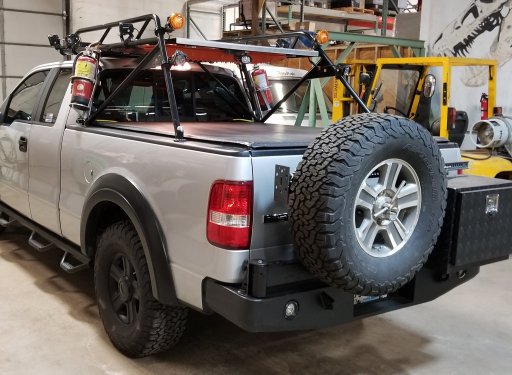
Thanks to all for their thoughtful input.
Currently, I have two rack mounted 10#ers and a small one in the cab.




